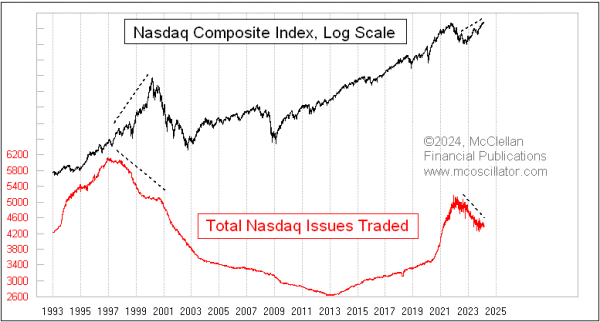|
April 18, 2024
The major averages may still be trending higher, but the total numbers of issues traded on the NYSE and Nasdaq peaked back in January 2022 and have been declining since then. This is not a bullish sign for the financial markets.
The Nasdaq market has looser listing standards than the NYSE, and so it attracts a larger number of total listings. But ease of doing an IPO on the Nasdaq sometimes means marginal companies which should not come public do so anyway, and then struggle afterward. For that reason, the Advance-Decline statistics for the Nasdaq have always had a bearish bias. In fact, the cumulative daily A-D Line for the Nasdaq has NEVER made a new all time high. It started going down from the beginning of the data in 1972, and it has never gotten back to that level, despite having more issues traded.
Having more IPOs can be a sign of an expanding economy. Perhaps it is better to say that expanding IPOs is a sign of easy money, such that even the marginal companies can still attract the capital to have a successful IPO. That increases the numbers of listed issues.
When the Fed started QE4 during Covid, and Congress threw its own pile of money at the economy, there was so much money sloshing around that the Nasdaq listings grew from around 3500 issues traded around the time of the Covid low in March 2020 to a high of 5175 in January 2022. The NYSE's total number of listed issues grew at that time too, although not by quite as much.
Now both are shrinking, as the marginal companies have revealed themselves and gotten delisted. Mergers and acquisitions also play a smaller part in the shrinkage.
One reason why this is meaningful is that a similar shrinkage in listed issues occurred leading up to the Internet bubble top in 2000. The high point for Nasdaq issues traded was actually back in December 1996, at 6136. By the time prices peaked for the Nasdaq Composite Index in March 2000, that number of Nasdaq issues traded was down to 5100, and it kept heading down.

One hard point about divergences is that they can last for a while, and they won't tell us when they are finally going to matter. But it cannot be seen as good news that money to invest is drying up, and the weak are getting picked off. In the stock market, illiquidity conditions initially come after the weak. But those same illiquidity conditions have a tendency of eventually mattering to even the biggest and supposedly most well-capitalized companies.
PRIOR ARTICLES:
Apr 11, 2024, Doctor Copper Has A Message On Inflation
Feb 14, 2024, Taxes Will Bite the Stock Market
May 11, 2023, NYSE A-D Line Adds to the List of Divergences
Tom McClellan
Editor, The McClellan Market Report
www.mcoscillator.com
|